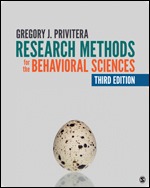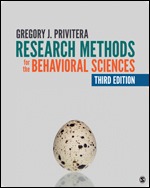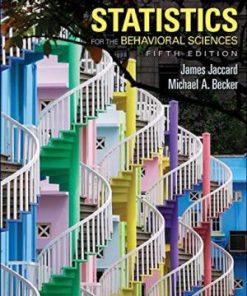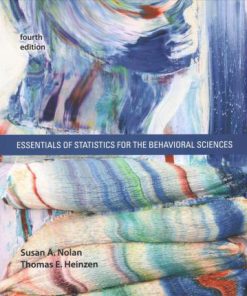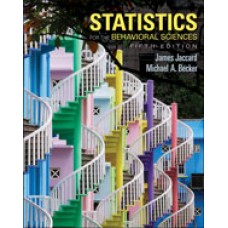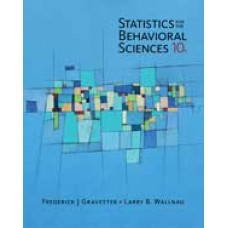Test Bank for Essential Statistics for the Behavioral Sciences 2nd by Privitera
$35.00 Original price was: $35.00.$26.50Current price is: $26.50.
Test Bank for Essential Statistics for the Behavioral Sciences 2nd by Privitera
Instant download Test Bank for Essential Statistics for the Behavioral Sciences 2nd by Privitera pdf docx epub after payment.
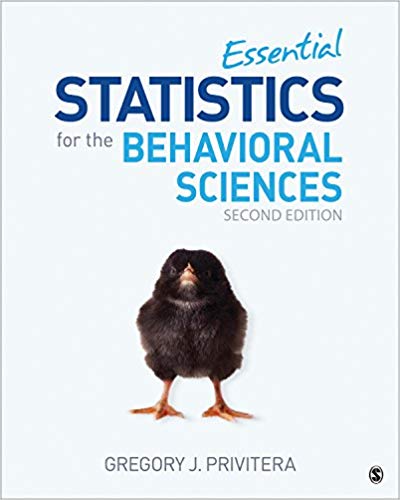
Product details:
- ISBN-10 : 1544324642
- ISBN-13 : 978-1544324647
- Author: Gregory J. Privitera
Essentials of Statistics for the Behavioral Sciences is a concise version of Statistics for the Behavioral Sciences by award-winning teacher, author, and advisor Gregory J. Privitera. The Second Edition provides balanced coverage for today’s students, connecting the relevance of core concepts to daily life with new introductory vignettes for every chapter, while speaking to the reader as a researcher when covering statistical theory, computation, and application. Robust pedagogy allows students to continually check their comprehension and hone their skills while working through carefully developed problems and exercises that include current research and seamless integration of IBM(R) SPSS(R) Statistics. Readers will welcome Privitera’s thoughtful instruction, conversational voice, and application of statistics to real-world problems.
Table of contents:
PART I: INTRODUCTION AND DESCRIPTIVE STATISTICS
Chapter 1: Introduction to Statistics
1.1 The Use of Statistics in Science
1.2 Descriptive and Inferential Statistics
1.3 Research Methods and Statistics
1.4 Scales of Measurement
1.5 Types of Variables for Which Data Are Measured
1.6 Research in Focus: Evaluating Data and Scales of Measurement
1.7 SPSS in Focus: Entering and Defining Variables
Chapter Summary Organized by Learning Objective
Key Terms
End-of-Chapter Problems
Chapter 2: Summarizing Data: Frequency Distributions in Tables and Graphs
2.1 Why Summarize Data?
2.2 Frequency Distributions for Grouped Data
2.3 Identifying Percentile Points and Percentile Ranks
2.4 SPSS in Focus: Frequency Distributions for Quantitative Data
2.5 Frequency Distributions for Ungrouped Data
2.6 Research in Focus: Summarizing Demographic Information
2.7 SPSS in Focus: Frequency Distributions for Categorical Data
2.8 Graphing Distributions: Continuous Data
2.9 Graphing Distributions: Discrete and Categorical Data
2.10 Research in Focus: Frequencies and Percents
2.11 SPSS in Focus: Histograms, Bar Charts, and Pie Charts
Chapter Summary Organized by Learning Objective
Key Terms
End-of-Chapter Problems
Chapter 3: Summarizing Data: Central Tendency
3.1 Introduction to Central Tendency
3.2 Measures of Central Tendency
3.3 Characteristics of the Mean
3.4 Choosing an Appropriate
3.5 Research in Focus: Describing Central Tendency
3.6 SPSS in Focus: Mean, Median, and Mode
Chapter Summary Organized by Learning Objective
Key Terms
End-of-Chapter Problems
Chapter 4: Summarizing Data: Variability
4.1 Measuring Variability
4.2 The Range and Interquartile Range
4.3 Research in Focus: Reporting the Range
4.4 The Variance
4.5 Explaining Variance for Populations and Samples
4.6 The Computational Formula for Variance
4.7 The Standard Deviation
4.8 What Does the Standard Deviation Tell Us?
4.9 Characteristics of the Standard Deviation
4.10 SPSS in Focus: Range, Variance, and Standard Deviation
Chapter Summary Organized by Learning Objective
Key Terms
End-of-Chapter Problems
PART II: PROBABILITY AND THE FOUNDATIONS OF INFERENTIAL STATISTICS
Chapter 5: Probability, Normal Distributions, and z Scores
5.1 Introduction to Probability
5.2 Calculating Probability
5.3 Probability and the Normal Distribution
5.4 Characteristics of the Normal Distribution
5.5 Research in Focus: The Statistical Norm
5.6 The Standard Normal Distribution and z Scores
5.7 A Brief Introduction to the Unit Normal Table
5.8 Locating Proportions
5.9 Locating Scores
5.10 SPSS in Focus: Converting Raw Scores to Standard z Scores
Chapter Summary Organized by Learning Objective
Key Terms
End-of-Chapter Problems
Chapter 6: Characteristics of the Sample Mean
6.1 Selecting Samples From Populations
6.2 Selecting a Sample: Who’s In and Who’s Out?
6.3 Sampling Distributions: The Mean
6.4 The Standard Error of the Mean
6.5 Factors That Decrease Standard Error
6.6 SPSS in Focus: Estimating the Standard Error of the Mean
6.7 APA in Focus: Reporting the Standard Error
6.8 Standard Normal Transformations With Sampling Distributions
Chapter Summary Organized by Learning Objective
Key Terms
End-of-Chapter Problems
Chapter 7: Hypothesis Testing: Significance, Effect Size, and Power
7.1 Inferential Statistics and Hypothesis Testing
7.2 Four Steps to Hypothesis Testing
7.3 Hypothesis Testing and Sampling Distributions
7.4 Making a Decision: Types of Error
7.5 Testing for Significance: Examples Using the z Test
7.6 Research in Focus: Directional Versus Nondirectional Tests
7.7 Measuring the Size of an Effect: Cohen’s d
7.8 Effect Size, Power, and Sample Size
7.9 Additional Factors That Increase Power
7.10 SPSS in Focus: A Preview for Chapters 8 to 14
7.11 APA in Focus: Reporting the Test Statistic and Effect Size
Chapter Summary Organized by Learning Objective
Key Terms
End-of-Chapter Problems
PART III: MAKING INFERENCES ABOUT ONE OR TWO MEANS
Chapter 8: Testing Means: One-Sample t Test With Confidence Intervals
8.1 Going From z to t
8.2 The Degrees of Freedom
8.3 Reading the t Table
8.4 Computing the One-Sample t Test
8.5 Effect Size for the One-Sample t Test
8.6 Confidence Intervals for the One-Sample t Test
8.7 Inferring Significance and Effect Size From a Confidence Interval
8.8 SPSS in Focus: One-Sample t Test and Confidence Intervals
8.9 APA in Focus: Reporting the t Statistic and Confidence Intervals
Chapter Summary Organized by Learning Objective
Key Terms
End-of-Chapter Problems
Chapter 9: Testing Means: Two- Independent-Sample t Test With Confidence Intervals
9.1 Introduction to the Between-Subjects Design
9.2 Selecting Samples for Comparing Two Groups
9.3 Variability and Comparing Differences Between Two Groups
9.4 Computing the Two-Independent- Sample t Test
9.5 Effect Size for the Two-Independent- Sample t Test
9.6 Confidence Intervals for the Two-Independent-Sample t Test
9.7 Inferring Significance and Effect Size From a Confidence Interval
9.8 SPSS in Focus: Two-Independent- Sample t Test and Confidence Intervals
9.9 APA in Focus: Reporting the t Statistic and Confidence Intervals
Chapter Summary Organized by Learning Objective
Key Terms
End-of-Chapter Problems
Chapter 10: Testing Means: Related-Samples t Test With Confidence Intervals
10.1 Related-Samples Designs
10.2 Introduction to the Related-Samples t Test
10.3 Computing the Related-Samples t Test
10.4 Measuring Effect Size for the Related-Samples t Test
10.5 Confidence Intervals for the Related-Samples t Test
10.6 Inferring Significance and Effect Size From a Confidence Interval
10.7 SPSS in Focus: Related-Samples t Test and Confidence Intervals
10.8 APA in Focus: Reporting the t Statistic and Confidence Intervals
Chapter Summary Organized by Learning Objective
Key Terms
End-of-Chapter Problems
PART IV: MAKING INFERENCES ABOUT THE VARIABILITY OF TWO OR MORE MEANS
Chapter 11: One-Way Analysis of Variance: Between- Subjects and Within- Subjects (Repeated- Measures) Designs
11.1 An Introduction to Analysis of Variance
11.2 The Between-Subjects Design for Analysis of Variance
11.3 Computing the One-Way Between-Subjects ANOVA
11.4 Post Hoc Tests: An Example Using Tukey’s HSD
11.5 SPSS in Focus: The One-Way Between-Subjects ANOVA
11.6 The Within-Subjects Design for Analysis of Variance
11.7 Computing the One-Way Within-Subjects ANOVA
11.8 Post Hoc Tests for the Within-Subjects Design
11.9 SPSS in Focus: The One-Way Within-Subjects ANOVA
11.10 A Comparison of Within-Subjects and Between-Subjects Designs for ANOVA: Implications for Power
11.11 APA in Focus: Reporting the Results of the One-Way ANOVAs
Chapter Summary Organized by Learning Objective
Key Terms
End-of-Chapter Problems
Chapter 12: Two-Way Analysis of Variance: Between-Subjects Factorial Design
12.1 Introduction to Factorial Designs
12.2 Structure and Notation for the Two-Way ANOVA
12.3 Describing Variability: Main Effects and Interactions
12.4 Computing the Two-Way Between-Subjects ANOVA
12.5 Analyzing Main Effects and Interactions
12.6 Measuring Effect Size for Main Effects and the Interaction
12.7 SPSS in Focus: The Two-Way Between-Subjects ANOVA
12.8 APA in Focus: Reporting the Results of the Two-Way ANOVAs
Chapter Summary Organized by Learning Objective
Key Terms
End-of-Chapter Problems
PART V: MAKING INFERENCES ABOUT PATTERNS, PREDICTION, AND NONPARAMETRIC TESTS
Chapter 13: Correlation and Linear Regression
13.1 The Structure of Data Used for Identifying Patterns and Making Predictions
13.2 Fundamentals of the Correlation
13.3 The Pearson Correlation Coefficient
13.4 SPSS in Focus: Pearson Correlation Coefficient
13.5 Assumptions and Limitations for Linear Correlations
13.6 Alternatives to Pearson: Spearman, Point-Biserial, and Phi
13.7 SPSS in Focus: Computing the Alternatives to Pearson
13.8 Fundamentals of Linear Regression
13.9 Using the Method of Least Squares to Find the Regression Line
13.10 Using Analysis of Regression to Determine Significance
13.11 SPSS in Focus: Analysis of Regression
13.12 A Look Ahead to Multiple Regression
13.13 APA in Focus: Reporting Correlations and Linear Regression
Chapter Summary Organized by Learning Objective
Key Terms
End-of-Chapter Problems
Chapter 14: Chi-Square Tests: Goodness of Fit and the Test for Independence
14.1 Distinguishing Parametric and Nonparametric Tests
14.2 The Chi-Square Goodness-of-Fit Test
14.3 SPSS in Focus: The Chi-Square Goodness-of-Fit Test
14.4 Interpreting the Chi-Square Goodness-of-Fit Test
14.5 The Chi-Square Test for Independence
14.6 Measures of Effect Size for the Chi-Square Test for Independence
14.7 SPSS in Focus: The Chi-Square Test for Independence
14.8 APA in Focus: Reporting the Chi-Square Tests
Chapter Summary Organized by Learning Objective
Key Terms
End-of-Chapter Problems
Afterword: A Final Thought on the Role of Statistics in Research Methods
Appendix A: Basic Math Review and Summation Notation
A.1 Positive and Negative Numbers
A.2 Addition
A.3 Subtraction
A.4 Multiplication
A.5 Division
A.6 Fractions
A.7 Decimals and Percents
A.8 Exponents and Roots
A.9 Order of Computation
A.10 Equations: Solving for x
A.11 Summation Notation
Key Terms
Review Problems
Appendix B. SPSS General Instructions Guide
Appendix C. Statistical Tables
Table C.1 The Unit Normal Table
Table C.2 Critical Values for the t Distribution
Table C.3 Critical Values for the F Distribution
Table C.4 The Studentized Range Statistic (q)
Table C.5 Critical Values for the Pearson Correlation
Table C.6 Critical Values for the Spearman Correlation
Table C.7 Critical Values for Chi-Square (c2)
Appendix D: Solutions for Even-Numbered Problems
Glossary
References
Index
People also search:
Essential Statistics for the Behavioral Sciences 2nd
Essential Statistics for the Behavioral Sciences 2nd pdf
Essential Statistics for the Behavioral Sciences
what is behavioral science statistics
fundamental statistics for the social and behavioral sciences
what is statistics for behavioral sciences
You may also like…
Solution Manual
Essential Statistics for the Behavioral Sciences 1st Edition Privitera Solutions Manual
Test Bank
Test Bank for Research Methods for the Behavioral Sciences, 3rd Edition, Gregory J. Privitera
Solution Manual
Solution Manual for Research Methods for the Behavioral Sciences 3rd Edition Gregory J. Privitera





